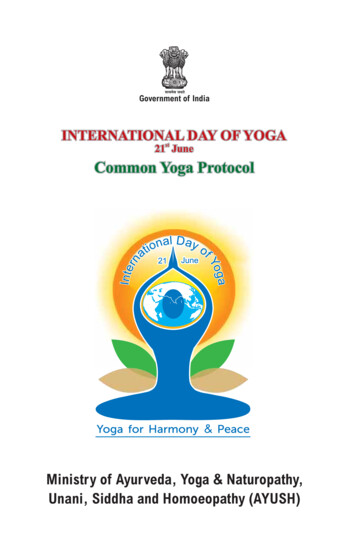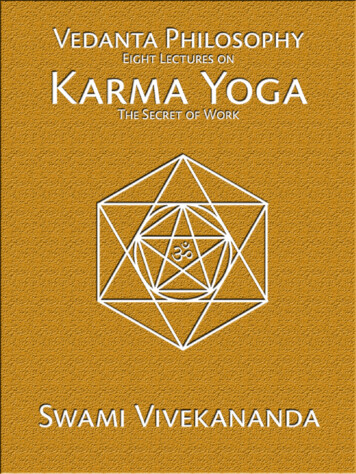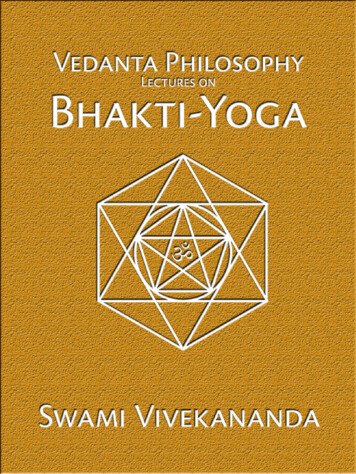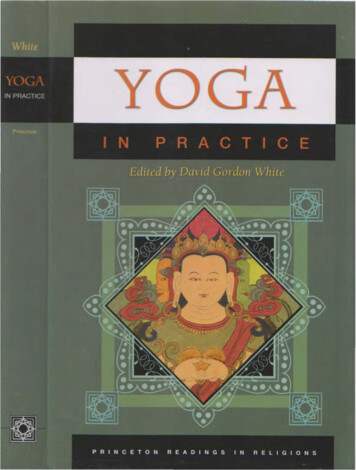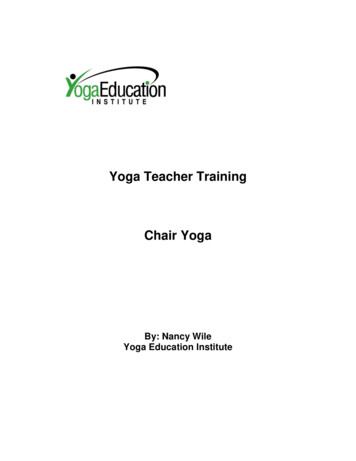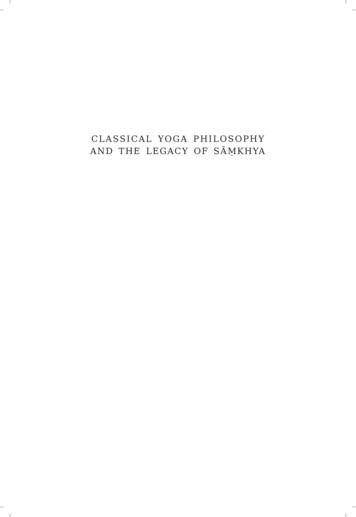
Transcription
CLASSICAL YOGA PHILOSOPHYA ND T HE L E G A CY O F SĀṂKHYA
CLASSICAL YOGA PHILOSOPHYA ND T HE L E G A CY O F SĀṂKHYAGerald James LarsonMOTILAL BANARSIDASS PUBLISHERSP R I VAT E L I M I T E D D E L H I
First Edition: Delhi, 2018 2018 by Gerald James LarsonAll Rights ReservedISBN:000-00-000-0000-0MOTILAL BANARSIDASS41 U.A. Bungalow Road, Jawahar Nagar, Delhi 110 0078 Mahalaxmi Chamber, 22Bhulabhai Desai Road, Mumbai 400 026Printed in India
T ableofC iationsxvIntroduction1-35Yogasūtrapāṭha (Sūtra-s Alone)36-68Brief Outline of the Contentof the Yogasūtra-s69-75Pātañjala-Yogadarśanam: Yogasūtra-s (YS)with Bhāṣya (VB) and Tattvavaiśāradī (TV) 77A Brief Preliminary Note to the Reader78-85Yogasūtra-s (YS) with Bhāṣya (VB)and Tattvavaiśāradī (TV) (Page Index)86-92The TranslatioNBook One (SAMĀDHI PĀDA)93-344Book Two (SĀDHANA PĀDA)345-600Book Three (VIBHŪTI PĀDA)601-839Book Four (KAIVALYA PĀDA)840-977Select Bibliography978-991Glossary of Sāṃkhya and Yoga Terminology992-1013Index1014-1023
PREFACEIt was in the summer of 1964 when I had completed my first year inthe doctoral program at Columbia University, New York City, the sameyear in which I had also completed my first full year of the study ofclassical Sanskrit, that an opportunity arose to do a summer readingcourse with a visiting professor of Sanskrit from India. He was onlyto be in the city for the summer, and a course in Sanskrit reading washastily set up to accommodate his brief visit. One other doctoral studentand I were available to take that brief reading course, and we decidedto read a reasonably short Sanskrit text, namely, the Sāṃkhyakārikā ofĪśvarakṛṣṇa. It was a welcome change from the tedium of Lanman’sSanskrit Reader (Nala, Hitopadeśa, Kathāsaritsāgara, and so forth),an opportunity for the first time to read a philosophical text, the sortof reading that had persuaded me to undertake the study of classicalSanskrit in the first place.I was enrolled in the joint Ph.D. program in the study of religion atUnion Theological Seminary and Columbia University, and my interestswere primarily in philosophy of religion and the history of religions. Ihad studied Heidegger’s Being and Time and Jean-Paul Sartre’s Beingand Nothingness (with John Macquarrie at Union Theological Seminary)and the general history of philosophy (with John Herman Randall atColumbia University). I had also begun serious reading in the intellectualhistory of India, including the principal Upaniṣads, the Bhagavadgītā,the commentaries of the great Advaitin, Śaṅkara, Nyāya logic, earlyBuddhist philosophizing, the work of Nāgārjuna and Vasubandhu,and, of course, the various Vedāntas. I was also reading the standardsecondary work commonly studied at that time, that is, the work of PaulDeussen, Erich Frauwallner, T. R. V. Murti, A. C. Mukerji, J. N. Mohanty,B. K. Matilal, et al.As we read the Sāṃkhyakārikā that summer, I recall two vividintellectual reactions. First, here was a philosophy of India dramaticallydifferent from the other traditions of Indian philosophy, an eccentricdualist ontology (not unlike the eccentric dualist ontology I had recentlyencountered in the work of Jean-Paul Sartre) that affirmed the productivereality of the natural, material world along with a notion of self (and/orconsciousness) as a pluralistic presence that was the antithesis of anysort of cosmic absolute (whether as Brahman, Ātman, God, Emptiness,
Prefaceviior whatever). Second, here also was a philosophy that had stimulatedconsiderable intellectual interest among scholars in the early modernhistoriography of the field of Indology (both Indian and European) (inthe work, for example, of R. Garbe, H. Oldenberg, Th. Stcherbatsky,A. B. Keith, S. N. Dasgupta, et al.) but was for the most part dismissedas a serious intellectual position, largely, it seemed to me, because ofthe negative critique of the Sāṃkhya philosophy in Śaṅkara’s famousBrahmasūtrabhāsya, a critique that as far as I could tell, as a youngscholar, had been uncritically cited by almost all interpreters but hadnever been properly critiqued itself. In other words, I had the sensethat Śaṅkara’s critique had come to be a standard “hit” piece vis-à-visSāṃkhya philosophy, not unlike what Hegel did in the nineteenth centuryto Indian philosophy in general. As Halbfass has commented regardingHegel’s influential critique of Indian philosophy:. . . Hegel’s negative statements on India and the Orient in general,and his pronouncement that “real philosophy” begins only in Greece,found wide acceptance, and they were taken as a justification todismiss Indian thought entirely from the historiography of philosophy,or to relegate it to a preliminary stage.1It appeared to me that both critiques, that of Śaṅkara and Hegel,mutatis mutandis, were motivated to a significant degree by a perceivedneed to come down hard on philosophical views that could possibly proveto be important rivals to their own positions. In the case of Hegel, Indianphilosophy, according to Hegel, was insufficiently grounded in historicalconsciousness and thus hopelessly limited to vacuous abstractionsin a “night in which. . . all cows are black.”2 In the case of Śaṅkara,the Sāṃkhya assertions of the reality of the natural, material world(pradhāna) and the pluralization of consciousness (puruṣa-bahutva)radically called into question the fundamental intuitions upon which the1. Wilhelm Halbfass, India and Europe: An Essay in Understanding (Albany, N.Y.: StateUniversity of New York Press, 1988), p. 98.2. See Hegel’s comment in his famous Preface to The Phenomenology of Mind, wellworth quoting again:“. . . yet in the Absolute, in the abstract identity A A, there is no such thing at all, foreverything is there all one. To pit this assertion, that “in the Absolute all is one”, againstthe organized whole of determinate and complete knowledge, or of knowledge which atleast aims at and demands complete development—to give out its Absolute as the night inwhich, as we say, all cows are black—that is the very naïveté of emptiness of knowledge.”Cf. G. W. F. Hegel, The Phenomenology of Mind, trans., by J. B. Baillie, Second Edition(London: George Allen & Unwin LTD, 1931), p. 79
viiiPrefaceAdvaita position was dependent, according to the revelations as foundin the mahāvākyas of śruti. More to the point, both critiques in theirrespective historical contexts were remarkably influential in undercuttingmuch if not all of subsequent philosophical hermeneutical interest, notonly of Sāṃkhya in the context of Indian thought, but of Indian philosophygenerally in the context of modern western philosophy. It was perhapsa ripe time, in my view, to reconsider these older views in traditionalIndian philosophy and in modern western thought, both historically andphilosophically.Willy-nilly, those two vivid reactions to my first reading of theSāṃkhyakārikā inclined me on a research trajectory, first, for my doctoraldissertation at Columbia in 1967; second, to the revision of that thesisinto my first book, Classical Sāṃkhya: An Interpretation of its History andMeaning in 1969 (and the second revised edition in 1979, reprinted mostrecently in 2014); third, to years of working together with a distinguishedpandit in India, Dr. Ram Shankar Bhattcharya, co-editing with him, in1987, Sāṃkhya: A Dualist Tradition in Indian Philosophy, and eventually,in 2011, Yoga: India’s Philosophy of Meditation, respectively volumes IVand XII of the Encyclopedia of Indian Philosophies, under the generaleditorship of Karl H. Potter. Apart from long introductory essays, theencyclopedia volumes include summaries of the contents of all Sanskritpublished texts on Sāṃkhya and Yoga that we could find from ancienttimes to the twentieth century.In the Epilogue to the first edition of my Classical Sāṃkhya, Iattempted to compare and contrast the eccentric Sāṃkhya dualismof puruṣa and prakṛti with the equally eccentric but strikingly similardualist ontology (the pour-soi and en-soi) of Jean-Paul Sartre in thehope of showing the salient difference of the Sāṃkhya dualism (as wellas the Sartrian dualism) from the garden-variety Cartesian dualismof western thought as well as the standard dualistic versions of theVedanttic philosophies in India. In the Epilogue to the second edition ofmy Classical Sāṃkhya in 1979, I attempted to offer what I think is thefirst serious critique of Śaṅkara’s critique of the Sāṃkhya philosophy,highlighting the manner in which Śaṅkara clearly misunderstoodthe nature of the Sāṃkhya dualism and thereby set in motion amisunderstanding of the Sāṃkhya philosophy, which continueseven now in some contemporary accounts of Sāṃkhya. In the twointroductory essays to the encyclopedia volumes mentioned above,I have tried to argue that classical Sāṃkhya philosophy is a creativeand original tradition of philosophical reflection, and far from being acurious piece of cosmological speculation, is in many ways one of the
Prefaceixtruly important intellectual achievements in India’s intellectual history.In a similar manner I have tried to argue that the philosophy of Yoga(as a samāna-tantra “common tradition”, or a “sāṃkhya-pravacana,”that is, an “interpretation or explanation of Sāṃkhya”) is unintelligiblephilosophically apart from the Sāṃkhya dualist ontology and its eccentricnotion of the “pluralization” of consciousness (puruṣa-bahutva).3I have come to appreciate more and more, in other words, what thegreat Gopinath Kaviraj said to me nearly half a century ago, when as ayoung postdoc at Banaras Hindu University I told him that I was studyingone of the systems of Indian philosophy, namely, the Sāṃkhya. He wavedhis arm to interrupt what I was saying, and commented, “Sāṃkhya isnot one of the systems of Indian philosophy; Saṃkhya is the philosophyof India!” He had in mind, of course, the remarkable influence that thebasic categories and notions of Sāṃkhya and/or Sāṃkhya-Yoga havehad on almost all aspects of Indian culture and learning in philosophy,mythology, theology, law, medicine, the arts, aesthetics, and the varioustraditions of tantra in the classical period. The ubiquitous presence ofthe Sāṃkhya network of notions (especially triguṇa, satkāryavāda andthe absolute differentiation, kaivalya, between puruṣa and citta-sattva)has functioned as an essential cultural “code” (to use a semiotics idiom)to which intellectuals in every phase of cultural life in India have felt aneed to respond, not always in agreement, to be sure, but as a startingpoint for their own conceptual constructions.The Present UndertakingThese days I am retired from two professorships, first, in 1995,having become professor emeritus, religious studies, the University ofCalifornia, Santa Barbara, and then second, in 2003, having becomeprofessor emeritus from the Rabindranath Tagore professorship ofIndian Culture and Civilization and director of India Studies, at IndianaUniversity, Bloomington.Because of the freedom for research thatemeritus status provides from full-time teaching, I decided to take up ademanding task that I had set aside during my active years of teaching,3. Through the years, I have returned on several occasions to offer further treatmentsof the manner in which the eccentric dualism and the equally eccentric notion of thepluralization of consciousness (puruṣa-bahutva) are distinctive notions for properlygrasping the purport of the classical philosophies of Sāṃkhya and Yoga, or perhaps better,classical Sāṃkhyayoga. Cf., for example, Gerald J. Larson, “An Eccentric Ghost in theMachine: Formal and Quantitative Aspects of the Sāṃkhya-Yoga Dualism,” PhilosophyEast and West, Vol. 33, No. 3, July (1983): 219-233; “K. C. Bhattacharyya on the Pluralityof Puruṣas (puruṣa-bahutva) in Sāṃkhya,” Journal of the Indian Council for PhilosophicalResearch, Vol. X, No. 1 (1992): 93-104; and “Materialism, Dualism and the Philosophy ofYoga,” International Journal of Hindu Studies, 17, 2 (2013) 183-221.
xPrefacenamely, the task of providing a new accessible English translation ofVācaspatimiśra’s Tattvavaiśāradī, an important commentary (Ṭīkā) onthe Yogasūtra of Patañjali together with the brief commentary (Bhāṣya),attributed to a certain Vedavyāsa.Vācaspatimiśra, an erudite scholar of Indian philosophy who livedin the middle of the tenth century (ca. 950 CE) in north India, althoughpersonally himself an intellectual adherent of the Advaita Vedānta ofŚaṅkara, composed a number of detailed commentaries on many ofthe other systems of Indian philosophy, including Sāṃkhya and Yoga.He composed a relatively short and elementary commentary on theSāṃkhyakārikā, entitled Sāṃkhyatattvakaumudī (“Moonlight on thetruth of Sāṃkhya”), followed thereafter by a major commentary (Ṭīkā) onthe Yogasūtra and its Bhāṣya, attributed to the legendary Vedavyāsa,entitled Tattvavaiśāradī (“A Skilled Clarification of the Truth”) (of Yoga).Vācaspatimiśra’s Tattvakaumudī on the Sāṃkhyakārikā is a ratherelementary commentary, offering little more than basic (althoughcertainly useful) explanations of the words of the various kārikā-s. Theverses of the Sāṃkhyakārikā, however, are fairly straightforward andreasonably intelligible in and of themselves. More than that, the versesof the Kārikā are explicitly characterized as a summary of a system ofthought, referred to as “the system of sixty” (“Ṣaṣṭitantra”), an older anddetailed formulation of an ancient account of Sāṃkhya, which provides asort of template for constructing an interpretation of classical Sāṃkhya.The Yogasūtra-s, to the contrary, are little more than laconicutterances that are largely unintelligible taken solely by themselves, andthroughout require a commentary for their interpretation. Furthermore,the commentary that accompanies the Yogasūtra-s, the so-calledBhāṣya, attributed (incorrectly according to most scholars) to thelegendary Vedavyāsa, is hardly a model of clarity. The Bhāṣya, ofcourse, provides much background information, but also often provideslittle more than passing notations that have led some interpreters tothink that the Bhāṣya is what is known as a svopajña composition, aself-composed set of notations on the Yogasūtra-s. Vācaspatimiśra’sTattvavaiśāradī, therefore, on the Yogasūtra and the Bhāṣya, attributedto Vedavyāsa, is a much more ambitious undertaking than his work inthe Tattvakaumudī, and it is essential reading for understanding theclassical Yoga of Patañjali (as found in the sūtra-s and its Bhāṣya). Itis a major and thorough discussion of the classical Yoga of Patañjali(and its Sāṃkhya philosophical environment) and has been profoundlyinfluential in all subsequent commentaries on both Yoga and Sāṃkhyafrom the tenth century through the present day, including the discussions
Prefacexiof the Yogasūtra-s by Aniruddha, Vijñānabhikṣu, et al., in the latercenturies (the sixteenth century and beyond). In my view, it is essentialto read the Yogasūtra-s and its Bhāṣya with the Tattvavaiśāradī (alongwith the Sāṃkhyakārikā and its commentaries) as the core literature ofclassical Sāṃkhyayoga.Vācaspatimiśra’s massive comment was translated into English overa century ago, first, in a rather casual manner by Rāma Prasāda (in theSacred Books of the Hindus series) in 1912 and then again in 1914, ina full scholarly treatment by James Haughton Woods entitled, The YogaSystem of Patañjali (as volume XVII of the Harvard Oriental Series). Aswill be discussed in the Introduction, however, both translations (while,of course, useful) are now quite dated both in terms of English usageand in terms of characterizing Sanskrit technical notions in a systematicmanner. At many points, both translations are nearly unintelligible whenread with or without the Sanskrit. More than that, as will be discussedin the sequel, neither translation sufficiently addresses the classicalSāṃkhya philosophical framework with which these Yoga texts areintimately related.The only other commentary that provides comparable informationon classical Sāṃkhya and Yoga is the recently translated (indeed, twicetranslated) text entitled, Pātañjalahyogaśāstra-vivaraṇa, attributed to thegreat Advaitin, Śankara. I say “twice-translated”, since there have beentwo complete translations which reach dramatically different conclusionsabout the Vivaraṇa. The first is that by Trevor Leggett entitled, TheComplete Commentary by Śaṅkara on the Yoga Sūtra-s (publishedby Kegan Paul International, in 1990), arguing that the commentary isby the great Advaitin, Śaṅkara, deriving from the eighth century. Thesecond is that of T. S. Rukmani, entitled, Yogasūtrabhāṣyavivaraṇa ofŚaṅkara (published by Munshiram Manoharlal, in 2001), arguing, tothe contrary, that the text is a much later commentary by a differentŚaṅkara than the great Advaitin, but possibly a follower of the greatAdvaitin, and having been composed somewhere between the tenthand fourteenth century. There has been considerable debate on bothsides by competent scholars, and it must be concluded that at thepresent time, no consensus has been reached. My own view is thatthe Vivaraṇa is somewhat later than Vācaspatimiśra’s Tattvavaiśāradībut that the authors and works of both were unknown to each other.Further research hopefully will clarify the relation between the two texts.I hope also that my new English translation of the Tattvavaiśāradī will behelpful in clarifying the significance of Vācaspatimiśra’s own views aswell as his own misunderstanding of some aspects of the sūtra-s and
xiiPrefacethe Bhāṣya, including his misunderstanding of the name of the author ofthe Bhāṣya, which, in my view, is not the legendary Vedavyāsa but morelikely the Sāṃkhya reformer, Vindhyavāsin.In any case, in 2003, I began a line by line daily reading of thePātañjala-yogasūtra, its Bhāṣya, and Vācaspatimiśra’s Tattvavaiśāradī,utilizing primarily the Sanskrit text as constituted by Ram ShankarBhattacharya, which is based for the most part on what is usuallyconsidered the “vulgate” edition of K. S. Āgāśe, et al., from 1904. Thereare still many passages in the text that appear unclear to me, both in theSanskrit and the various English translations, even after twelve years ofongoing work, and I invite other Sanskrit scholars to offer suggestionsand/or corrections based on their own reading. Overall, however, Ihope that the translation that I am offering is an improvement of ourunderstanding of these texts at this time in the still unfolding history ofthe philosophy of Sāṃkhya and Yoga.Let me offer two final prefatory remarks. The title of this bookis Classical Yoga Philosophy and the Legacy of Sāṃkhya.By thistitle I wish to underscore that the philosophy of classical Yoga as setforth in the Yogasūtra, attributed to Patañjali, is, as the colophons tothe manuscripts to its basic Bhāṣya attest, a “sāṃkhya-pravcana,” thatis to say, “an interpretation and/or explanation of the philosophy ofSāṃkhya.” I also wish to underscore my view that the attribution of thecompilation of the sūtra-s to the famous grammarian, Patañjali, authorof the Mahābhāṣya, may well warrant revisiting, insofar as the sūtra-s inthe famous yogāṅga-portion of the text (YS II.28 ff.) may well be tracedto an earlier time, as J. W. Hauer suggested many years ago. It iscertainly the case, as will be discussed in the Introduction, that the nameof the famous grammarian was commonly associated with classicalYoga by about the time of Vācaspatimiśra and Bhoja, that is, themiddle of the tenth century or the early eleventh century, and probablymuch earlier. Moreover, my view that the author of the Bhāṣya is theSāṃkhya reformer, Vindhyavāsin, which follows earlier discussions byAshok Aklujkar, et al., and is supportive of the suggestion that there maypossibly be a link (for example, sphoṭa-theory) between the philosophyof Yoga and the grammarian tradition in the intellectual history of Indiain these early centuries.
xiiiAcknowledgementsIhave been assisted through the years by many colleagues in variousfields in the preparation of this work, and I would like to take this occasionto mention the names of at least a few of the most important. First andforemost, I would mention Dr. Ram Shankar Bhattacharya, with whomI read the texts of Sāṃkhya and Yoga, beginning in my post-doc year(1968-69) at Banaras Hindu University in Varanasi, India, and continuingmany years thereafter from the late 1960s onwards to his untimely deathin June of 1996. While critical methods of traditional pandits are ofteninterestingly different from modern scholarly methods, there finally is nosubstitute for reading classical Sanskrit with a traditional pandit by waygaining a fuller access to the nuances of Sanskrit interpretation that gobeyond the scholastic rules for understanding the meaning of a Sanskrittext.Second, I decided to provide a complete text of the Sanskrit of thetexts included in this volume, namely, the Yogasūtra, its Bhāṣya, and animportant Ṭīkā on the Bhāṣya, entitled Tattvavaiśāradī, by the famoustenth-century polymath scholar of Indian philosophy, Vācaspatimiśra,and to do so in the Devanāgarī script so that the text would be easilyaccessible to both English readers as well as students and scholarsin India. I have used the original text that is commonly used in printededitions from the Ānandāśramasaṃsktagranthāvali, volume 47, asfound in Ram Shankar Bhattacharya’s edition of this old “vulgate” edition(and see Select Bibliography for details). The texts have been re-typedby a young Sanskrit scholar in Nepal, Prabhakar Wagle, in consultationwith me and with Sthaneshwar Timalsina, religious studies professorand Sanskritist, California State University, San Diego.Third, I wish to acknowledge the technical computer assistance ofJames Aeby, software specialist, book designer and editorial consultant,of Iris Studio, Bakersfield, CA. Jim has worked tirelessly over many monthsin designing the format and presentation of the various components ofthis volume. Also, in regard to computer assistance, I would like tothank Dwayne Pack, director of computing of the School of Humanitiesof the University of California, Irvine. I have been in conversation with
xivAcknowledgementsDwayne for several years in trying to work out possible online accessfor this volume and other publications of mine. Moreover, Dwayne hasdesigned and maintains my website (www.geraldjameslarson.com) forwhich I am continuously grateful.Fourth, many of my former doctoral students, now professorsat institutions around the world, have read portions of this volume invarious stages of its preparation. Two in particular deserve specialmention, Professor Knut A. Jacobsen, history of religions, Universityof Bergen, Norway, and Professor Wade Dazey, professor of religiousstudies, University of Wisconsin, Whitewater. In addition, I wish tothank Professor Jonathan Edelmann, University of Florida, Gainsville,who spent hours reading significant portions of this volume and kindlyprovided many pages of helpful corrections and suggestions. Needlessto say, of course, I bear full responsibility for all of the content of thisvolume.Finally, I would like to mention that fifty years ago (in the fall of the1968-69 academic year when I was a postdoc at BHU) I met Mr. N.P. Jain of Motilal Banarsidass at a conference in Patna in the State ofBihar, India. He asked me if he could read my recently revised doctoraldissertation from Columbia University, New York City. He then, in turn,introduced me to Sundarlal Jain, proprietor of Motilal Banarsidass,who offered to publish the manuscript that same academic year. Thatmanuscript became my first book, Classical Sāṃkhya: An Interpretationof its History and Meaning (1969; second revised edition in 1979; andreprinted most recently in 2017). Through the years I have come toknow N. P. Jain, J. P. Jain, R. P. Jain and most recently Rajeev Jain,and many of their associates at Motilal Banarsidass. The family will beamused when I say that they taught me that contrary to the old cliché,there is, indeed, such a thing as a free lunch! I have had many of themwith the Jain family through these five decades of our association, and Iam delighted that they will be publishing this final volume of mine in the80th year of my current rebirth!‘asato mā sad gamaya,tamaso mā jyotir gamaya,mṛtyor mā ‘mṛtaṃ gamaya!’(Bṛhad. Up. I.3.28)Oṃ śantiḥ śāntḥ śāntiḥ!
ABBREVIATIONS(A) TEXTS, SERIES, ia of Indian PhilosophiesHarvard Oriental SeriesPātañjala-yoga-śāstra-vivaraṇaSacred Books of the HindusSāṃkhya: A Dualist Traditionin Indian Philosophy, IVSāṃkhya-kārikāTattva-kaumudī of VācaspatimiśraTattvavaiśāradī of VācaspatimiśraVyāsa BhāṣyaVācaspatimiśraYoga: India’s Philosophy of Meditation, XIIYuktidīpikāYogasūtra-s(B) JOURNALSAJPASESBSOASIJHSJAOSJIPJRASPE&WAmerican Journal of PhilologyAsiatische Studien Études AsiatiquesBulletin of the School of Orientaland African StudiesInternational Journal of Hindu StudiesJournal of the American Oriental SocietyJournal of Indian PhilosophyJournal of the Royal Asiatic SocietyPhilosophy East and West
INTRODUCTIONThe purpose of this book is to present a systematic discussion ofthe philosophy of classical Yoga as an interpretation and furtherelucidation of the philosophy of classical Sāṃkhya, based uponnew translations into English of the three most important texts ofphilosophical Yoga, namely, the Yoga-sūtra-s, attributed to a certainPatañjali and usually called the Pātañjala-yoga-sūtra or Pātañjala-yogaśāstra (hereafter simply YS) (ca. CE 350-450); its basic commentary(the Bhāṣya) attributed to the legendary Vedavyāsa (hereafter the VB)(likewise ca. CE 350-450); and a long sub-commentary called a Ṭīkā(or Vyākhyā) entitled Tattvavaiśāradī (“ A Skilled Clarification of theTruth”) (of Yoga) (hereafter TV) composed by the well known scholar ofIndian philosophy, Vācaspatimiśra (hereafter VM) (ca. CE 950).1 Thetotal complex of the translation includes the four sections (or Pāda-s)of the YS, inclusive of the “Samādhi Pāda,” “the concentration section”(with 51 sūtra-s), the “Sādhana Pāda,” “the meditative practice section”(with 55 sūtra-s), the “Vibhūti Pāda,” “the extraordinary cognitive statessection” (with 55 sūtra-s) and “Kaivalya Pāda,” “the spiritual freedomsection” (with 34 sūtra-s). The sūtra-s, taken together alone (withoutcommentary), or what is known as the “sūtrapāṭha,” number 195. Takentogether by themselves in this manner, the sūtra-s are for the most partnearly impossible to understand, making clear that there has probablybeen a long tradition of oral interpretation, traceable through a seriesof traditional teachers (guru-paraṃparā).2 Written commentaries in thecase of the YS probably began already with the Bhāṣya attributed tothe legendary Vedavyāsa (or the VB). In this regard, the laconic natureof the VB almost appears at times to be a set of scholarly notations,suggesting perhaps that the VB is what is known as a “self-composed”(svopajña) commentary. The Ṭīkā (or Vyākhyā) of Vācaspatimiśra, onthe other hand, is a much more elaborate and dense discussion of thesūtrapāṭha and the VB. Even with both commentaries, moreover, thefull significance of the Pātañjala-yoga-sūtra-s (YS) remains elusive. Thedates for all three texts are only approximate as is often the case forSanskrit philosophical texts in the early centuries, especially for the YSand VB, which could easily be plausibly dated in a wider range of ca.CE 200-600.
2IntroductionI have used the so-called “vulgate” editions of these texts, sincethese editions are the only complete texts currently available for all foursections or Pāda-s of the YS, the VB and the TV. I have neverthelessalso had the benefit of utilizing a new critical edition of a small portionsection I (or Pāda I) (the Samādhi Pāda) of the VB in the recent workof Philipp André Maas in his edition, Samādhipāda: The First Chapterof the Pātañjalayogaśāstra for the First Time Critically Edited.3 Maasalso includes in Appendix I, in collaboration with Kengo Harimoto, apossible reconstruction of the text of Pāda I (the Samādhi Pāda) of thePātañjala-yoga-śāstra-vivaraṇa (hereafter PYSV), ascribed, thoughwith some considerable controversy, to the well-known Advaita Vedāntaphilosopher, Śaṅkara.4Date and authorship of the PYSV remain problematic, but it maywell turn out to be an older commentary on the YS, according to Maas.Although Maas’s work is only, thus far, a critical edition of the firstsection of the YS and the VB (and not inclusive of the TV), it involvesan exhaustive catalogue of the manuscripts and printed editions ofthe various relevant texts along with detailed variant readings. Maasis skeptical about determining an original version of the YS and VBbecause of a long history of errors in the transmission of manuscripts; heis, nevertheless, able to identify both a “Northern group” and a “Southerngroup” of texts in transmission.5 Maas designates the “Northern group”as the basis for what he calls a “normative recension” or “vulgate”edition, widely used throughout India.6 The “Southern group,” to whichMaas assigns the PYSV, is possibly older and may well represent anolder version of the VB. These conclusions await, of course, completionof the critical edition of all four sections of the VB and resolution of theissues of date and authorship of the PYSV. The shortcoming of Maas’swork, in my view, is that he does not proceed to translate or critically toanalyze his proposed critical text for Pāda I, nor does he address thephilosophical content of what he studies. He is solely interested in thephilological study of the ancient manuscripts (and see Larson, 2009:487-98). In the interim, of course, a new English translation of the TVwill have to be based on one or the other ‘vulgate’ editions, and I havechosen to use the edition in the Ānandāśrama series (and see note 1),which is generally recognized as
Advaita position was dependent, according to the revelations as found in the mahāvākyas of śruti. More to the point, both critiques in their . In a similar manner I have tried to argue that the philosophy of Yoga (as a samāna-tantra "common tradition", or a "sāṃkhya-pravacana," that is, an "interpretation or explanation of .

